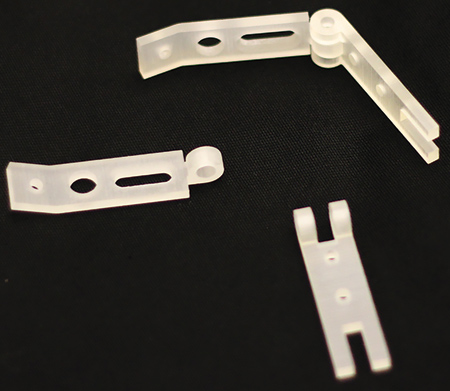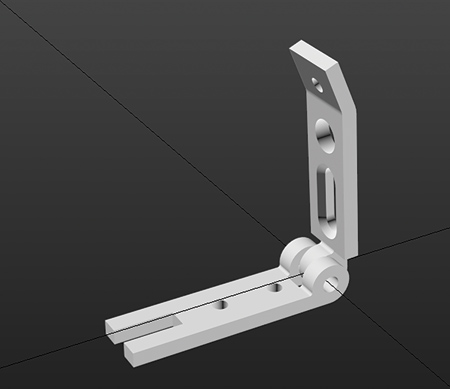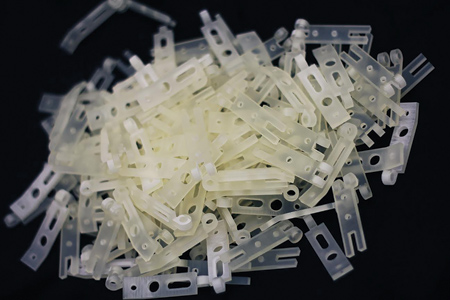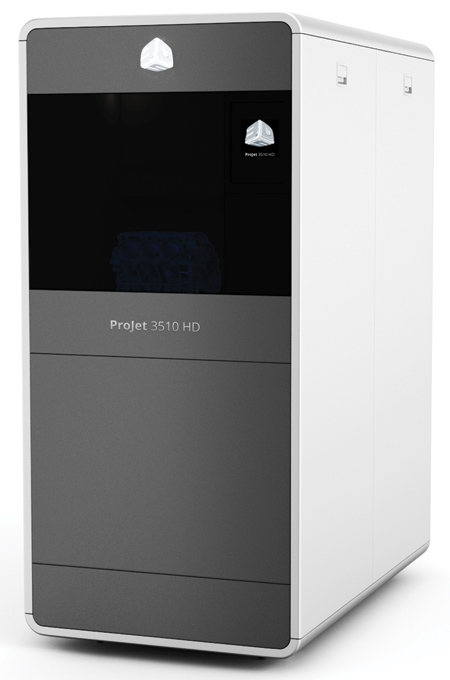
CAD Model of hinge assembly ready for 3-D Printing

3-D printed hinge after finishing

Completed run of 3-D printed hinges

ProJet 3510 HD
3-D printing is a process for making a physical object from a 3-D digital model by laying down successive thin layers of a material in an additive process. In product development, 3-D printing is often used to create prototypes. Products are created in iterations to test and measure how well they will work. Once finalized, tooling for the product is created based on the most effective version.
Traditionally, prototyping is used to catch errors and faults in product development. The earlier in the product development life cycle errors are caught, the less expensive it is to fix those errors. Most of the time, after the prototypes are made, expensive molds and tooling are created for the production of thousands of copies of the product. But, what happens if only a short run of about 100 copies of a product is needed and the tooling costs are in excess of $10,000? Midwest-based MasterGraphics Inc. helped find a solution for a manufacturing company that faced this exact problem.
The company in this example manufactures and stocks standard products for metal fabricators and produces custom products for architectural and industrial systems. It had created a hinge fixture that would slightly change the angle of an LED mount and redirect the light beam. The company had two important requirements for this project: cost and accuracy. It only needed 100 or so copies of this plastic hinge. The estimated tooling cost for this project was about $10,000. Tooling for this sort of job was not cost effective, so the company contacted MasterGraphics to determine if 3-D printing could be a solution. The hinge would need to be 3-D printed with a tolerance that was fine enough to fit the exact performance specifications.
There are a few different options for 3-D printing to those specific tolerance requirements. Stereolithography (SLA), selective laser sintering (SLS) and multijet printing (MJP) are 3-D printing technologies that allow for the creation of fine, high-tolerance parts. SLA technology uses a photopolymer liquid resin and a high intensity light source to cure fine layers and support structures for the part. Once the product is printed, support structures are removed and the designed part remains. SLS technology uses a finely powdered material, spreading across a platform. Then a high-powered laser is used to fuse the material for that layer, and another fine layer of material is spread over the previous layer, repeating the process until the part is complete. The uncured remaining powder surrounding and supporting the part is then reclaimed for future prints.
One of the newer technologies for 3-D printing is called MJP. It provides high-resolution parts with complex geometry - and was a great fit for this customer's needs. MJP uses a print head to jet multiple materials onto a platform layer by layer. An ultraviolet light cures the jetted material into the desired form using wax to support it. Once the support wax is melted away, the plastic part is left.
A 3D Systems MJP Projet 3500 printer was a good fit for this application because it allows for 3-D print layer heights of 32 to 16 µm, and prints within .001" to .002" of the CAD design. To test if the acrylate plastic was a good fit for the application, a single copy of the hinge was printed to ensure form and fit. This verified that the precision of the 3-D printer would fit the manufacturer's specifications.
There are many different materials that are used in 3-D printing, and testing for production is an extremely important step. After a quick test, it was determined that the 3-D printed part would function just as well as the manufactured part. The manufacturer decided to have MasterGraphics print 100 copies of the hinge at about 1/10 of the cost of tooling. On top of the reduced cost of the hinge components, the manufacturer received its short run production in just a couple of days, as opposed to a few weeks.
"Using a 3-D printer for short run production can be cost and time effective. Whether printing the final production part, printing the necessary tooling or printing the mold used to create parts, all three reduce cost and time to manufacture," said a company spokesperson. "Today's technologies are allowing companies to have many options when it comes to precision parts. Having 3-D printing at your disposal is invaluable to custom and short run precision manufacturing."
Authored by Jack Wolf, 3-D Support Specialist, MasterGraphics Inc.
For more information contact:
MasterGraphics
2979 Triverton Pike Drive
Madison, WI 53711
800-873-7238 / 608-256-4884
www.mastergraphics.com